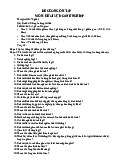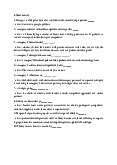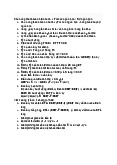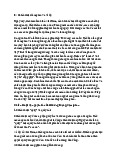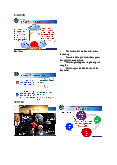













Preview text:
PSU-MGT 403 SAIS LESSON 1
1. A creative, distinctive strategy that delivers a sustainable competitive advantage is important
because a strategy that yields a competitive advantage over rivals is a company’s most reliable
means of achieving above-average profitability and financial performance. True
2. A company achieves sustainable competitive advantage when
a. a sufficiently large number of buyers have a lasting preference for its products or
services as compared to the offerings of competitors.
3. Which of the following is a frequently used strategic approach to setting a company apart
from rivals and achieving a sustainable competitive advantage?
a. Striving to be the industry’s low-cost provider, thereby aiming for a cost-based competitive advantage
b. Outcompeting rivals on the basis of such differentiating features as higher quality,
wider product selection, added performance, better service, more attractive styling, or technological superiority
c. Developing competitively valuable resources and capabilities that rivals can’t easily
match, copy, or trump with capabilities of their own
d. Focusing on a narrow market niche and winning a competitive edge by doing a better
job than rivals of serving the special needs and tastes of buyers comprising the niche e. All of these
4. The need on the part of company managers to make regular adjustments in the company’s
business model is one of the basic reasons that a company’s strategy evolves over time. FALSE
5. Which of the following statements about a company’s realized strategy is true?
a. A company’s realized strategy is typically a blend of deliberate/planned initiatives and
emergent/ unplanned reactive strategy elements.
6. The elements of a company’s business model are its business strategy, its customer value
proposition as well as the company’s profit formula. FALSE
7. A winning strategy is one that
a. fits the company’s internal and external situation, builds sustainable competitive
advantage, and improves company performance.
8. Which of the following questions ought to be used to distinguish a winning strategy from a so-so or flawed strategy?
a. Is the strategy well-matched to the company’s situation, helping the company achieve
a sustainable competitive advantage, and resulting in better company performance?
9. The strategic management process is shaped by
a. external factors such as the industry’s economic and competitive conditions and
internal factors such as the company’s collection of resources and capabilities.
10. The strategy-making, strategy-executing process is primarily the responsibility of top
executives and the board of directors; very few managers below this level are involved. FALSE
11. Which one of the following is not an accurate attribute of an organization’s strategic vision?
a. Outlining how the company intends to implement and execute its business model
12. The difference between the concept of a company mission statement and the concept of a strategic vision is that
a. a mission statement typically concerns a company’s present business scope (“who we
are and what we do”) whereas the principal concern of a strategic vision is with the
company’s future business scope (long term direction and future product-customer- market-technology focus).
13. Strategic objectives relate to strengthening a company’s overall market standing and competitive vitality. TRUE
14. A balanced scorecard that includes both strategic and financial performance targets is a
conceptually strong approach for judging a company’s overall performance because
a. financial performance measures are lagging indicators that reflect the results of past
decisions and organizational activities whereas strategic performance measures are
leading indicators of a company’s future financial performance 15. Corporate strategy
a. ensures consistency in strategic approach among businesses of a diversified, multibusiness corporation.
16. Ethical principles as they apply to business conduct and business decisions are materially
different from ethical principles in general. FALSE
17. The major drivers of unethical business behavior include
a. corporate cultures that put the bottom line ahead of ethics, heavy pressures on
company managers to meet or beat performance targets, and overzealous or obsessive
pursuit of wealth accumulation, power, status, and other selfish interests.
18. The costs incurred when ethical wrongdoing is done fall into three specific categories and include all except
a. intangible costs such as legal and investigative costs incurred by the company.
19. Which of the following is not generally on a company’s menu of actions to consider in
crafting a strategy of social responsibility?
a. Actions to look out exclusively for the best interests of shareholders 20. Good corporate citizens
a. go beyond meeting society’s expectations for ethical strategies and business behavior
by fostering social benefit and balancing the interests of all.
21. Environmental sustainability involves
a. deliberate actions to protect the environment and provide for the longevity of
resources, maintain ecological support systems for future generations, and guard
against the ultimate endangerment of the planet.
22. Companies committed to environmental sustainability consider the commitment to
shareholders as a “first-order” priority, commitment to employees as a “second-order”
priority, and commitment to the environmental protection as a “third-order” commitment. FALSE LESSON 2
1. A company’s “macro-environment” refers to
a) all the relevant forces and factors outside a company’s boundaries–general economic conditions,
population demographics, societal values and lifestyles, technological factors, and governmental legislation and regulation.
2. Which one of the following is not part of a company’s macro-environment?
a) The company’s resource strengths, resource weaknesses, and competitive capabilities
3. Which of the following is not a major question to ask in thinking strategically about the
industry and competitive conditions in a given industry?
a) How many companies in the industry have good track records for revenue growth and profitability?
4. Thinking strategically about industry and competitive conditions in a given industry involves
evaluating such considerations as a) All of the above
5. Which of the following is not a factor to consider in identifying an industry’s dominant economic features?
a) The role and pace of technological change
6. Which of the following is not a relevant consideration in identifying an industry’s dominant economic features?
a) The number and sizes of buyers, the number of rivals, and the pace of product innovation
7. The state of competition in an industry is a function of a) All of these
8. The nature and strength of the competitive forces that prevail in an industry is generally a joint product of the a) All of these
9. Which of the following is not one of the five typical sources of competitive pressures?
a) The power and influence of industry driving forces
10. Whether buyer bargaining power poses a strong or weak source of competitive pressure on
industry members depends in part on
a) whether buyer demand is strong or declining
11. The “driving forces” in an industry
a) are major underlying causes of change in industry and competitive conditions and
have the biggest influences in reshaping the industry landscape and altering competitive conditions 12. Industry conditions change
a) Because forces create pressures or incentives for industry participants (competitors,
customers, suppliers) to alter their actions in important ways
13. The steps involved in driving forces analysis are
a) Identifying the driving forces, assessing whether their impact will make the industry
more or less attractive, and determining what strategy changes are needed to prepare
for the impact of the driving forces. 14. Driving forces analysis
a) involves identifying the driving forces, assessing whether their impact will make the
industry more or less attractive, and determining what strategy changes a company
may need to make to prepare for the impact of the driving forces. 15. A strategic group
a) is a cluster of industry rivals that have similar competitive approaches and market positions.
16. A strategic group consists of those firms in an industry that
a) employ similar competitive approaches and occupy similar positions in the market.
17. Which of the following is not an appropriate guideline for developing a strategic group map for a given industry?
a) The variables chosen as axes for the map should be highly correlated.
18. Not all positions on a strategic group map are equally attractive because
a) across-group rivalry is strongest at the outer edges of the strategic group map.
19. The payoff of good scouting reports on rivals is improved ability to
a) predict what strategic moves rivals are likely to make next, thereby allowing a
company to prepare defensive countermoves and develop strategies to exploit rivals’ missteps.
20. Having good competitive intelligence about rivals’ strategies, latest actions and
announcements, resource strengths and weaknesses, and moves to improve their situation is important because
a) it helps a company to anticipate what moves rivals are likely to make next and to craft its own strategic moves.
21. The key success factors in an industry
a) are the strategy elements, intangible assets, and competitive capabilities that most
affect industry members’ abilities to prosper in the marketplace.
22. An industry’s key success factors
a) can be determined through identifying an industry’s dominant economic
characteristics, assessing the five competitive forces, considering the impacts of the
driving forces, comparing the market positions of industry members, and forecasting
the likely next moves of industry rivals.
23. Which of the following factors should a company consider when determining if an industry
offers good prospects for attractive profits?
a) The industry’s growth potential, whether competition appears destined to become
stronger or weaker, how the industry’s driving forces might affect overall industry
profitability, the company’s competitive position relative to rivals, and the company’s
proficiency in performing industry key success factors
24. Evaluating whether an industry presents a sufficiently attractive business opportunity usually
does not involve a consideration of which of the following factors?
a) Whether the industry’s product is strongly or weakly differentiated
25. One important indicator of how well a company’s present strategy is working is whether
a) its strategy is built around at least two of the industry’s key success factors.
26. Which one of the following is not a reliable measure of how well a company’s current strategy is working?
a) The company’s development of human capital, organizational capital, and information capital 27. A resource-based strategy
a) uses a company’s valuable and rare resources and competitive capabilities to deliver
value to customers that rivals have difficulty matching 28. A resource-based strategy
a) attempts to exploit resources in a manner that offers value to customers in ways rivals are unable to match.
29. One of the most telling signs of whether a company’s market position is strong or precarious is
a) whether its prices and costs are competitive with those of key rivals.
30. Two analytical tools useful in determining whether a company’s prices and costs are competitive are
a) value chain analysis and benchmarking.
31. The value of doing competitive strength assessment is to
a) learn how the company ranks relative to rivals on each of the important factors that
determine market success and ascertain whether the company has a net competitive
advantage or disadvantage vis-à-vis key rivals.
32. Doing a competitive strength assessment entails
a) ranking the company against major rivals on each of the important factors that
determine market success and ascertaining whether the company has a net competitive
advantage or disadvantage versus major rivals.
33. Identifying the strategic issues a company faces and compiling a “worry list” of problems and
roadblocks is an important component of company situation analysis because
a) the “worry list” sets the management agenda for taking actions to improve the
company’s performance and business outlook.
34. Which of the following is not accurate as concerns the task of identifying the strategic issues
and problems that merit front-burner managerial attention?
a) Identifying the strategic issues and problems that the company faces is the first thing
that company managers need to do before starting to analyze the company’s internal and external environment. LESSON 3-4
1. Which of the following is not one of the five generic types of competitive strategy?
a. Market share dominator strategy
2. The generic types of competitive strategies include
a. low-cost provider, broad differentiation, focused low-cost, focused differentiation, and best-cost provider strategies.
3. A company’s competitive strategy deals with
a. management’s game plan for securing a competitive advantage relative to rivals.
4. A low-cost leader’s basis for competitive advantage is
a. lower overall costs than competitors.
5. A competitive strategy of striving to be the low-cost provider is particularly attractive when
a. price competition is especially vigorous, buyers have low switching costs, and the
majority of industry sales are made to a few, large volume buyers.
6. To succeed with a low-cost provider strategy, company managers have to
a. do two things: (1) perform value chain activities more cost-effectively than rivals and
(2) be proactive in revamping the firm’s overall value chain to eliminate or bypass
“nonessential” cost-producing activities.
7. Successful differentiation allows a firm to
a. command a premium price for its product and/or increase unit sales and/or gain buyer loyalty to its brand.
8. Perceived value and signaling value are often an important part of a successful differentiation strategy when a. All of these
9. Broad differentiation strategies generally work best in market circumstances where
a. buyer needs and preferences are too diverse to be fully satisfied by a standardized product.
10. What sets focused (or market niche) strategies apart from low-cost leadership and broad differentiation strategies is
a. their concentrated attention on a narrow piece of the overall market.
11. A focused low-cost strategy seeks to achieve competitive advantage by
a. serving buyers in the target market niche at a lower cost and lower price than rivals.
12. A focused differentiation strategy aims at securing competitive advantage
a. with a product or service offering carefully designed to appeal to the unique
preferences and needs of a narrow, well-defined group of buyers.
13. A firm pursuing a best-cost provider strategy
a. seeks to deliver superior value to buyers by satisfying their expectations on key
quality/service/features/ performance attributes and beating their expectations on price
(given what rivals are charging for much the same attributes).
14. The aim of the best-cost provider strategy is to create a competitive advantage by
a. incorporating attractive or upscale product attributes at a lower cost than rivals
15. For a best-cost provider strategy to be successful, a company must have
a. the capability to incorporate upscale attributes at lower costs than rivals whose
products have similar upscale attributes
16. Which of the following is not among the principal offensive strategy options that a company can employ?
a. Blocking the avenues open to challengers
17. A hit-and-run or guerrilla warfare type offensive strategies involve
a. unexpected attacks (usually by a small competitor) to grab sales and market share
from complacent or distracted rivals.
18. Which one of the following is not an offensive strategy option?
a. Deliberately attacking those market segments where key rivals make big profits
19. The purposes of defensive strategies include
a. lowering the risk of being attacked by rivals, weakening the impact of any attack that
occurs, and influencing challengers to aim their offensive efforts at other rivals.
20. Which one of the following is not a good example of a defensive strategy to protect a
company’s market share and competitive position?
a. Engaging in a preemptive strike strategy in an effort to discourage rivals from being aggressive
21. First-mover advantages are unlikely to be present in which one of the following instances?
a. When rapid market evolution (due to fast-paced changes in technology or buyer
preferences) presents opportunities to leapfrog a first mover’s products with more
attractive next-version products
22. In which of the following instances are first-mover disadvantages not likely to arise?
a. When rivals are employing offensive strategies rather than defensive strategies
23. Vertical integration strategies
a. extend a company’s competitive and operating scope because its operations extend
across more parts of the total industry value chain.
24. The two most compelling reasons for a company to pursue vertical integration (either forward or backward) are to
a. strengthen the company’s competitive position and/or boost its profitability.
25. Outsourcing strategies
a. involve farming out value chain activities presently performed in-house to outside
specialists and strategic allies.
26. The big risk of employing an outsourcing strategy is
a. hollowing out the competitive capabilities a company needs to be a master of its own destiny.
27. The big risk of employing an outsourcing strategy is
a. hollowing out a firm’s own capabilities and losing touch with activities and expertise
that contribute fundamentally to the firm’s competitiveness and market success.
28. A strategic alliance
a. is a formal agreement between two or more companies in which there is strategically
relevant collaboration of some sort, joint contribution of resources, shared risk, shared
control, and mutual dependence.
29. The reasons firms enter into strategic alliances is to a. All of these
30. Mergers and acquisitions are often driven by such strategic objectives as to
a. expand a company’s geographic coverage, extend its business into new product
categories, or gain quick access to new technologies or other resources and capabilities.
31. Mergers and acquisitions
a. all too frequently do not produce the hoped-for outcomes.
32. The reasons a company opts to expand outside its home market include
a. gaining access to new customers for the company’s products/services.
b. spreading its business risk across a wider market base.
c. achieving lower costs and enhancing the company’s competitiveness.
d. a desire to capitalize on its core competencies and capabilities. e. All of these
33. Which of the following is not a typical reason for a company to expand into the markets of foreign countries?
a. To strengthen its capability to employ offensive strategies, especially those that involve preemptive strikes
34. Which of the following is not an accurate statement as concerns competing in the markets of foreign countries?
a. A multicountry strategy is generally superior to a global strategy.
35. Competing in the markets of foreign countries entails dealing with such factors as a. All of these
36. The advantages of manufacturing goods in a particular country a. All of these
37. Which of the following is not one of the strategy options for expanding into markets of foreign countries?
a. A profit sanctuary strategy
38. The advantages of using an export strategy to build a customer base in foreign markets include
a. minimizing capital requirements and involvement in foreign markets.
39. The advantages of using a licensing strategy to participate in foreign markets include
a. being able to leverage the company’s technical know-how or patents without
committing significant additional resources to markets that are unfamiliar,
politically volatile, economically uncertain, or otherwise risky.
40. A “think local, act local” multidomestic type of strategy
a. is more appealing the bigger the country-to-country differences in buyer tastes,
cultural traditions, and marketing methods.
41. A “think local, act local” multidomestic strategy works particularly well when a. All of the above
42. A “think global, act global” approach to crafting a global strategy involves a. All of the above
43. To use location to build competitive advantage, a company that operates multinationally or globally must
a. consider (1) whether to concentrate each activity it performs in a few select
countries or disperse performance of the activity to many nations and (2) in which
countries to locate particular activities.
44. Which one of the following is not one of the elements of crafting corporate strategy for a diversified company?
a. Choosing the appropriate value chain for each business the company has entered
45. The three tests for judging whether a particular diversification move can create value for shareholders are
a. the attractiveness test, the cost-of-entry test, and the better-off test.
46. The cost-of-entry test for evaluating whether diversification into a particular industry is
likely to build shareholder value involves
a. considering whether a company’s costs to enter the target industry are so high that
the potentials for good profitability and return on investment are eroded.
47. The three tests for judging whether a particular diversification move can create value for shareholders are
a. the attractiveness test, the cost-of-entry test, and the better-off test.
48. The most popular strategy for entering new businesses and accomplishing diversification is
a. acquisition of an existing business already in the chosen industry.
49. A joint venture is an attractive way for a company to enter a new industry when
a. the opportunity is too risky or complex for a company to pursue alone or when a
company lacks some important resources or competencies and needs a partner to supply them.
50. The essential requirement for different businesses to be “related” is that
a. their value chains possess competitively valuable cross-business relationships.
51. Which of the following is an important appeal of a related diversification strategy?
a. Offers opportunities to transfer skills, expertise, technical know-how, or other
capabilities from one business to another
52. The best place to look for cross-business strategic fits is
a. anywhere along the respective value chains of related businesses—no one place is best
53. Which of the following is a diversified business with one major “core” business and a
collection of small related or unrelated businesses?
a. Dominant business enterprise
54. The principal managerial actions and initiatives undertaken in the strategy execution
process include which of the following?
a. Instituting policies and procedures that facilitate rather than impede effective strategy execution
55. The principal managerial actions and initiatives undertaken in the strategy execution
process include which of the following? a. All of these.
56. The three components of building a capable organization are
a. staffing the organization, building core competencies and competitive capabilities,
and structuring the organization and work effort.
57. Building an organization capable of good strategy execution entails
a. staffing the organization, building core competencies and competitive capabilities,
and structuring the organization and work effort. I.Short answer
1. Managers in all types of businesses must address the central strategic question
Answer: How are we going to get there
2. A company achieves sustainable competitive advantage when
Answer: a sufficiently large number of buyers have a lasting preference for its products or services
as compared to the offerings of competitors.
3. A company’s business model -
Answer: clarifies (1) how the business will provide customers with value, and (2) why the
business will generate revenues sufficient to cover costs and produce attractive profits
4. A company’s strategic vision concerns -
Answer: a company’s directional path and future product-customer-market-technology focus
5. A company’s mission statement typically addresses
Answer: Who we are, what we do, and why we are here
6. A company’s values concern
Answer: the beliefs, traits, and behavioral norms that company personnel are expected to display
in conducting the company’s business and pursuing its strategic vision and mission. 7. A strategic group
Answer: is a cluster of industry rivals that have similar competitive approaches and market positions 8. Industry conditions change
Answer: because forces create pressures or incentives for industry participants (competitors,
customers, suppliers) to alter their actions in important ways.
9. The payoff of good scouting reports on rivals is improved ability to
Answer: predict what strategic moves rivals are likely to make next, thereby allowing a company
to prepare defensive countermoves and develop strategies to exploit rivals’ missteps.
10. The key success factors in an industry
Answer: are the strategy elements, intangible assets, and competitive capabilities that most affect
industry members’ abilities to prosper in the marketplace 11. A resource-based strategy
Answer: uses a company’s valuable and rare resources and competitive capabilities to deliver
value to customers that rivals have difficulty matching
12. Two analytical tools useful in determining whether a company’s prices and costs are competitive are
Answer: value chain analysis and benchmarking.
13. A company’s competitive strength scores
Answer: determine whether a company has a cost-effective value chain
14. The generic types of competitive strategies include
Answer: low-cost provider, broad differentiation, focused low-cost, focused differentiation, and best-cost provider strategies.
15. A low-cost leader’s basis for competitive advantage is
Answer: lower overall costs than competitors II. Essay
1. Vietcombank (VCB) is the first bank in Vietnam to allow every customer can send money in
one place and make withdrawals at any point in the system transactions.
From 2018, customers can use the service with VCB – ibanking by information retrieval
functionality through collaborating with service providers, VCB increase advantage for
customers utility VCB-iBanking with transfers, payment of travel services, telephone charges / internet , airfare , etc. .. .
Besides, in 2021 VCB has provided automatic Investment Services when the deposit payment on
account of your business beyond a certain level called the floor level , the excess amount will be
automatically transferred to a special account Special - automatic investment account . When the
balance of the deposit account payment is lower than the floor level, the money will be
automatically transferred from investment accounts on deposit accounts paying your enterprise .
With the use of these services can help businesses reduce costs are a significant number of
customer service. Thereby reducing the cost of doing business increases the competitiveness of enterprises in the market Question:
1.a. What is VCB’s strategy in 2018? Explain
VCB’s strategy in 2018 is Focused differentiation strategy. Concentrating on a narrow
buyer segment (or market niche) and outcompeting rivals by offering niche members
customized attributes that meet their tasted and requirements better than rivals’ products.
1.b What is VCB’s strategy in 2021? Explain
VCB’s strategy in 2021 is Best-cost provider strategy. Giving customers more value
for the money by satisfying buyers’ expectations on key
quality/features/performance/service attributes while beating their price expectations.
2. Enjoy is one of famous company that specialize in cake, biscuit, cookies. Enjoy’s target market
is major domestic market. In recent years, the company’s sale is good, this result is from regularly
releasing many products that are suitable with taste of customer. However, beginning of 2019, a
problem that affect to operation of company is the quantity and quality of eggs that were provided
by famers went down continuously. These famers had offered reasons that were low-margin
industry and poor. In order to deal with this situation, Enjoys have established mass chicken farm
so as to prepare amount of eggs for cake manufacture in 2019. Năm 2020, Enjoy also has made an
investment to real-estate project in Ho Chi Minh city and Hanoi city
Question: a. What was the strategy of Enjoy in 2019? Explain
The strategy of Enjoy in 2019 is Backward integration strategy. Because it iqnvolves
performing industry value chain activities previously performed by suppliers or other
enterprises engaged in earlier stages of the industry valued chain.
b. What was the strategy of Enjoy in 2020? Explain.
The strategy of Enjoy in 2020 is Unrelated diversification strategy. Because
having value chains and resource requirements that are so dissimilar that no
competitively valuable cross-business relationships are present.
